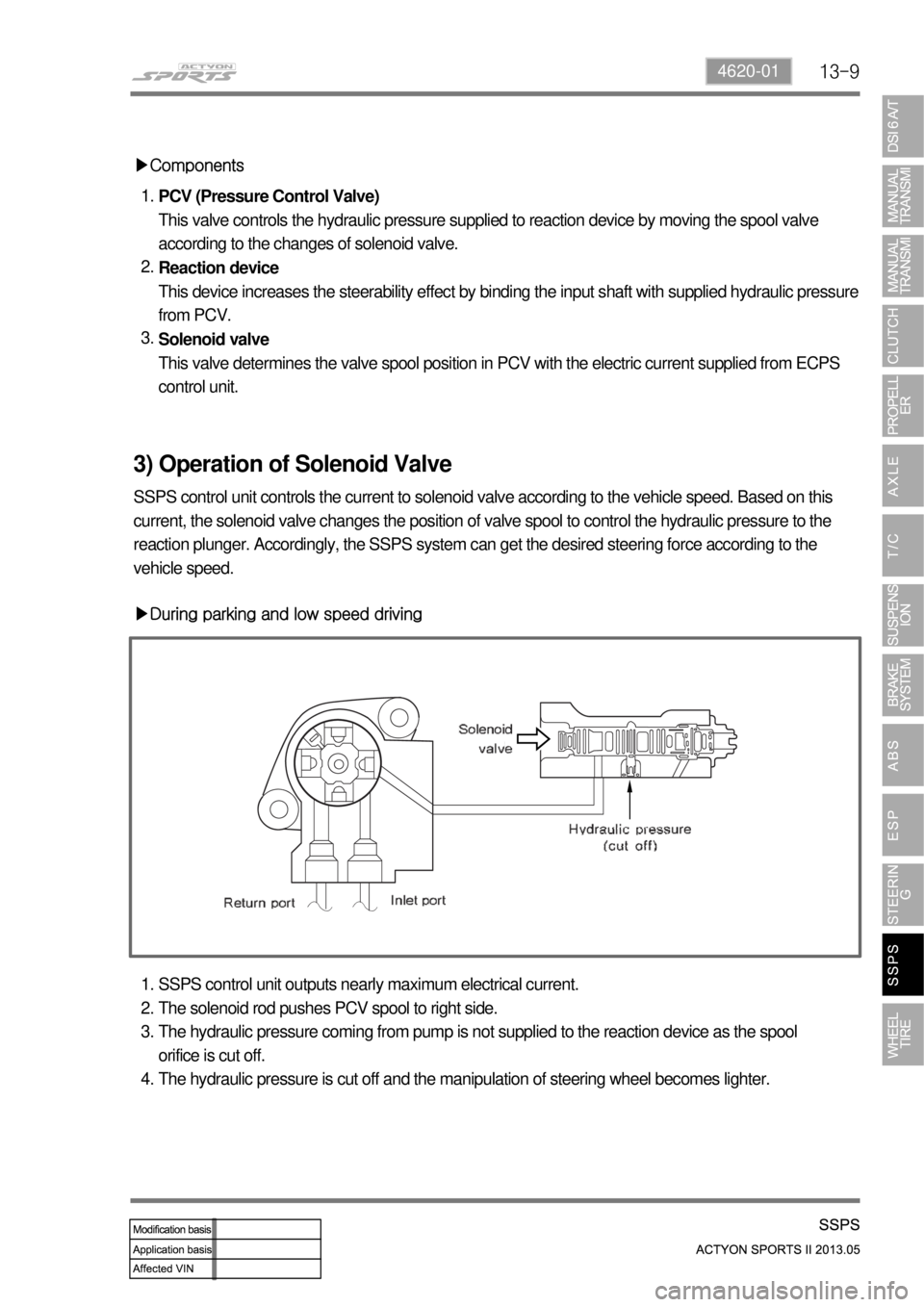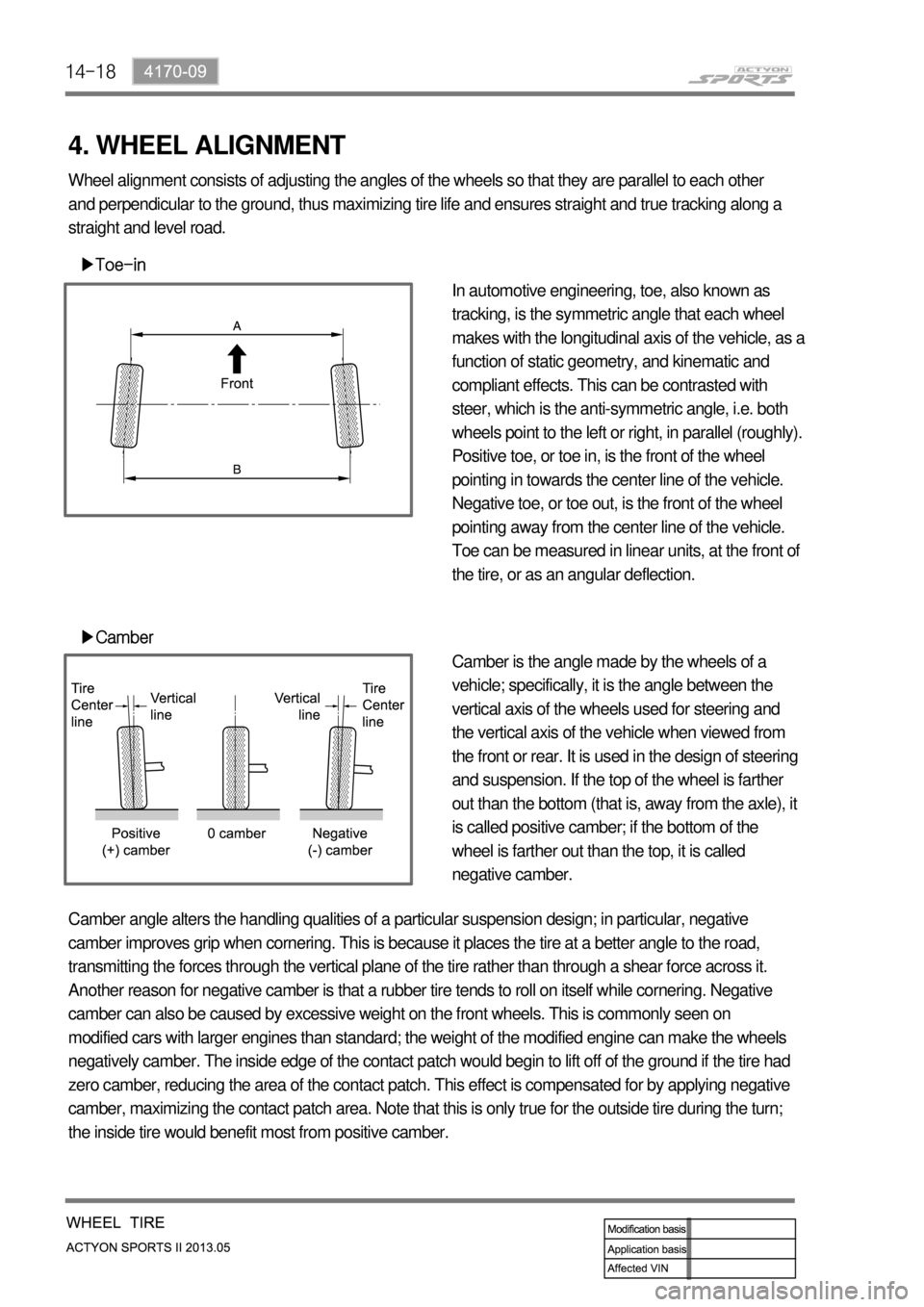Page 657 of 751
13-74620-01
SSPS warning lamp
Comes on when SSPS system has a fault
Power steering supply hose and return hose for
SSPS model
Power steering pump with SSPS
Installed view Pump components
Page 659 of 751

13-94620-01
▶Components
PCV (Pressure Control Valve)
This valve controls the hydraulic pressure supplied to reaction device by moving the spool valve
according to the changes of solenoid valve.
Reaction device
This device increases the steerability effect by binding the input shaft with supplied hydraulic pressure
from PCV.
Solenoid valve
This valve determines the valve spool position in PCV with the electric current supplied from ECPS
control unit. 1.
2.
3.
3) Operation of Solenoid Valve
SSPS control unit controls the current to solenoid valve according to the vehicle speed. Based on this
current, the solenoid valve changes the position of valve spool to control the hydraulic pressure to the
reaction plunger. Accordingly, the SSPS system can get the desired steering force according to the
vehicle speed.
▶During parking and low speed driving
SSPS control unit outputs nearly maximum electrical current.
The solenoid rod pushes PCV spool to right side.
The hydraulic pressure coming from pump is not supplied to the reaction device as the spool
orifice is cut off.
The hydraulic pressure is cut off and the manipulation of steering wheel becomes lighter. 1.
2.
3.
4.
Page 661 of 751
13-114620-01
4) System Control
ECPS system, according to the vehicle speed,
enables to achieve proper steering
characteristics by controlling hydraulic
pressure to reaction plunger located in input
shaft of power steering gear box. In other words,
ECPS control unit enhances the parking
conveniences by controlling duty type current
control. It provides heavy steerability with low
current as the vehicle speed increases. And, it
provides light steerability with high current as the
vehicle speed decreases.
▶During parking and low speed driving
During parking and driving in low speed, the control unit supplies approx. 1 A of electric current to
solenoid valve. Then, the spool located in PCV compresses the upper spring and elevates upward and,
the working pressure from oil pump (A port) is not able to flow to the reaction plunger (C port). As a
result, the pressing force from reaction plunger disappears and the steerability enhances.
Page 663 of 751
13-134620-01
4. S.S.P.S (SPEED SENSITIVE POWER STEERING)
Page 668 of 751

14-74170-09
2) Typical Inspection
Tread
Inspect the tread condition on the tire surface
and various damages resulting from the
foreign materials, crack, stone or nail etc. If
there is any damage in the tire, repair or
replace it. 1.
Wear limit 2.
Measure the depth of the tire tread. If the
depth of the tread is below the specified
value, replace the tire -
You can see the protruded part in the
groove at the point with mark "▲", which
is the indicator of the tread wear limit.
The limit of the tread wear for all season
tires are 1.6 mm, which is the same as the
general tires, but the wear limit mark is
indicated as '↓'. -
-
Wear limit 1.6 mm
Higher than recommended pressure can cause hard ride, tire bruising or damage and rapid tread
wear at the center of the tire.
Excessive tire wear over the limit of the tread wear (1.6 mm) can cause lower sliding friction due to
longer braking distance, easy tire burst by foreign materials, tire hydroplaning, and tough brake and
steering wheel handling. -
-
Page 677 of 751
14-16
When the vehicle is driven on a road surface covered with water at high speed, tires do not contact with
the road surface but rotate floating on a thin film of water.
It causes brake failure, lower traction force and losing the steering performance.
To prevent this, increase the tire inflation pressure, use tires with leaf shape tread which is not worn.
However, it is a best measure to drive slowly. Hydro Planing ▶
Vehicle speed ≤ 60 km/h
No Hydro planningVehicle speed = 80 km/h
Partial Hydro planningVehicle speed ≥ 100 km/h
Full Hydro planing
Page 679 of 751

14-18
4. WHEEL ALIGNMENT
▶Toe-in
▶Camber
In automotive engineering, toe, also known as
tracking, is the symmetric angle that each wheel
makes with the longitudinal axis of the vehicle, as a
function of static geometry, and kinematic and
compliant effects. This can be contrasted with
steer, which is the anti-symmetric angle, i.e. both
wheels point to the left or right, in parallel (roughly).
Positive toe, or toe in, is the front of the wheel
pointing in towards the center line of the vehicle.
Negative toe, or toe out, is the front of the wheel
pointing away from the center line of the vehicle.
Toe can be measured in linear units, at the front of
the tire, or as an angular deflection.
Camber is the angle made by the wheels of a
vehicle; specifically, it is the angle between the
vertical axis of the wheels used for steering and
the vertical axis of the vehicle when viewed from
the front or rear. It is used in the design of steering
and suspension. If the top of the wheel is farther
out than the bottom (that is, away from the axle), it
is called positive camber; if the bottom of the
wheel is farther out than the top, it is called
negative camber. Wheel alignment consists of adjusting the angles of the wheels so that they are parallel to each other
and perpendicular to the ground, thus maximizing tire life and ensures straight and true tracking along a
straight and level road.
Camber angle alters the handling qualities of a particular suspension design; in particular, negative
camber improves grip when cornering. This is because it places the tire at a better angle to the road,
transmitting the forces through the vertical plane of the tire rather than through a shear force across it.
Another reason for negative camber is that a rubber tire tends to roll on itself while cornering. Negative
camber can also be caused by excessive weight on the front wheels. This is commonly seen on
modified cars with larger engines than standard; the weight of the modified engine can make the wheels
negatively camber. The inside edge of the contact patch would begin to lift off of the ground if the tire had
zero camber, reducing the area of the contact patch. This effect is compensated for by applying negative
camber, maximizing the contact patch area. Note that this is only true for the outside tire during the turn;
the inside tire would benefit most from positive camber.
Page 680 of 751

14-194170-09
▶Caster
Caster is the angle to which the steering pivot
axis is tilted forward or rearward from vertical, as
viewed from the side. If the pivot axis is tilted
backward (that is, the top pivot is positioned
farther rearward than the bottom pivot), then the
caster is positive; if it's tilted forward, then the
caster is negative.
Positive caster tends to straighten the wheel
when the vehicle is traveling forward, and thus is
used to enhance straight-line stability. The
mechanism that causes this tendency is clearly
illustrated by the castering front wheels of a
vehicle. The steering axis of a vehicle wheel is
set forward of where the wheel contacts the
ground. As the vehicle is driving forward, the
steering axis pulls the wheel along, and since the
wheel drags along the ground, it falls directly in
line behind the steering axis. The force that
causes the wheel to follow the steering axis is
proportional to the distance between the steering
axis and the wheel-to-ground contact patch-the
greater the distance, the greater the force. This
distance is referred to as "trail."